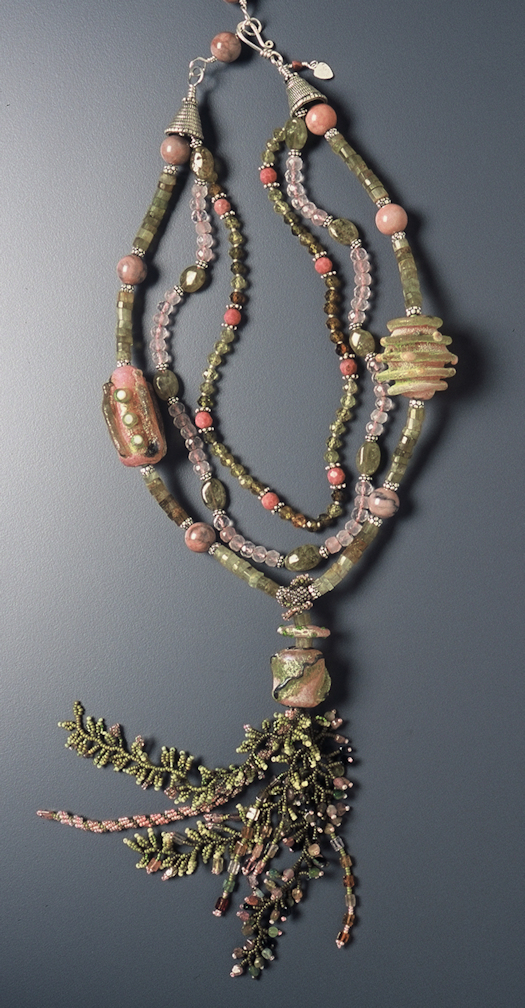Margie Deeb asked me to make a piece using the colors of a hawk moth in its natural environment. What an honor to get a request like this!! The book is a fabulous reference for any artist, not just beadworkers. Karen made the gorgeous beads just for this project. I searched every gem show in Tucson (well OK, a LOT of gem shows in Tucson) for just the right stones. Karen's beads work beautifully with stone because they have the most extraordinary finishes and highly naturalistic shapes. Note that I've rotated Melinda's beautiful photograph so it will fit on this page.
The garnets are called "grossular" for their color: the word comes from the Latin grossulara, gooseberry fruit. Some say garnets enhance charisma. I've noticed that people seem drawn to caress these lovely garnets. The Crystal Ally Cards (below) link garnet with prosperity.
Rhodonite, opaque pinkish material, is known as the thoughtful one. It balances the rose quartz, the love stone, the stone of romance.
The tiny shapes in the tassel are tourmalines which are said to foster inner peace. Johari (see link below) says that in Indian medicine, tourmaline is never inauspicious and always benefits its wearers by conducting light waves, balancing the electrochemical system, calming and enhancing concentration, absorbing evil, etc.
The teeniest bits in the tassel are faceted andalusite, interesting in that it is a polymorph with kyanite and sillimanite meaning that it shares the same chemistry but has a different crystal structure. Andalusite is supposed to assist with problem solving, an attribute which was very helpful in making this necklace!
As long as we're writing a dissertation, we must not overlook the subject of this piece, the hawk moth. There are an estimated 850 species worldwide. The hawk moth was made famous by Darwin when one was found which matched his prediction that there must be a moth with an extremely long proboscis which could pollinate a highly unusual orchid. The much beloved tomato horn worm (just kidding, though you have to admit it is beautiful!) is a hawk moth caterpillar. Moth wings are covered with scales which differ slightly from the wing scales of their close cousins the butterflies. Despite being nocturnal, female moths have a corner on the "attraction" market: they release pheromones which can lure the males from great distances, up to 3 miles for the silkworm moth. The males have pheromone receptors on their frilly antennae (see them in the tassel?). For this reason, Andrews (below) gives the moth the attribute of fertility. The total transformation (metamorphosis) undergone by moths and butterflies serves as a lesson for us all. Alice (below) mentions it in her conversation with the caterpillar.
Don Juan (below) says, "If you want to be accurate in sorcerers' terms, but very ridiculous in your own terms, you could say that tonight you had an appointment with a moth. Knowledge is a moth ...The moths are the heralds or, better yet, the guardians of eternity ... For some reason, or for no reason at all they are the depositories of the gold dust of eternity."
This necklace is featured in Margie Deeb's fabulous book The Beader's Color Palette (see below).



